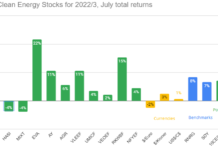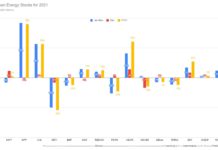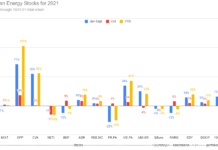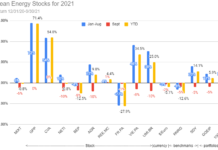Tom Konrad CFA
2015 marks my seventh annual list of ten clean energy stocks. An equal weighted portfolio of the ten stocks in each year’s list has outperformed my industry benchmark every year except 2013. 2014 was no exception, but it was a bittersweet victory in that the model portfolio was slightly down while the benchmark lost considerably more in a very challenging year for clean energy stocks.
I will publish a wrap-up article for the 2014 list in the next couple days, but I wanted to get the 2015 list out on New Year’s day.
Again this year, I will be providing a high and low target for each stock. These are the range within which I expect the stocks to end the year. In 2014, three of the picks violated the downside targets, and none violated the upside targets. I’ve also included annual dividends and yield, and Beta, a measure of market risk for US stocks. Low Beta stocks generally perform better than high Beta stocks in market downturns; the market average Beta is 1.
Finally, I include a discussion of insider sentiment: company insiders buying or selling the stock. Since company insiders usually receive stock as part of their compensation, insider sales are generally more common than insider purchases. Hence insider buying is almost always a good sign, and I consider it particularly important in the small capitalization stocks I favor. These stocks are more likely to be mispriced than larger, more widely followed stocks for which there is much more information available to investors. Company insiders are the ones most likely to see such mispricing. Since insider trading information is much easier to find for US stocks than foreign stocks, I include links to my sources of information for insider trading.
Income Stocks
1. Hannon Armstrong Sustainable Infrastructure (NYSE:HASI).
Current Price: $14.23. Annual Dividend: $1.04 (7.3%). Beta: 0.81. Low Target: $13.50. High Target: $17.
Insider Sentiment: Mildly Positive. One insider is selling but three are buying; sale was an automatic sale which is unlikely to be a response to market conditions.
Why it’s green: All financed projects reduce greenhouse gas emissions.
Hannon Armstrong is a Real Estate Investment Trust and investment bank specializing in financing sustainable infrastructure. I consider it a peer of the yieldcos (companies that invest in clean energy infrastructure and use the cash flows to pay a high dividend yield to shareholders, but HASI trades at a substantial discount to most yieldcos because other investors seem to compare it more closely to mortgage REITs. However, Hannon Armstrong’s investments are very different from those of other mortgage REITs.
In 2014, management delivered on it promise to increase the dividend by 12-15%, something they expect to do again in 2014. In 2014, the stock increased only 3.2% for a 9.9% total return for the year. With the dividend yield now even higher than it was a year ago and more dividend increases likely, I expect even better results in 2015.
2. General Cable Corp. (NYSE:BGC)
Current Price: $14.90. Annual Dividend: $0.72 (4.8%). Beta: 1.54. Low Target: $10. High Target: $30.
Insider Sentiment: Mildly Positive. No trades in last 3 months, but insiders are not selling incentive awards. One officer was buying at much higher prices ($21+) in August.
Why it’s Green: The geographically dispersed nature of renewable energy resources means they require more wire/connections. Improving the interconnection of our grid also allows utilities to use existing generation more efficiently.
General Cable Corp. is a leading international manufacturer for electrical and fiber optic cable. In 2014, the company disappointed investors because of weak demand for electricity infrastructure, especially in Europe. The company is undertaking a restructuring to focus on its core markets in the Americas and Europe. The company is also searching for a new CEO and expanding its board to include more members with operational experience.
With the company trading near book value with healthy cash per share and in the process of selling its Asia Pacific operations, only a reduction in uncertainty should be needed to bring investors back to the stock.
3. Capstone Infrastructure Corp (TSX:CSE. OTC:MCQPF).
Current Price: C$3.20. Annual Dividend C$0.30 (9.4%). Low Target: C$3. High Target: C$5.
Insider Sentiment: Strongly Positive; 200,150 shares bought by 8 insiders over 3 months. Only sale was of preferred stock by an insider also buying common.
Why it’s green: Capstone’s energy division sells electricity and heat from gas cogeneration, wind, solar, and hydropower. I consider its utilities climate-neutral.
Capstone was included in the 2014 list because I expected the worst possible result in its negotiations with the Ontario Power Authority over the future of its Cardinal gas cogeneration plant had already been priced in. That thesis initially paid off, with the stock rising significantly during the first half of the year. Unfortunately, Britain’s water regulator OfWat issued a final determination for rates at its Bristol Water subsidiary which fell considerably short of what the utility had proposed and vetted with consultants. Bristol Water is considering appealing the ruling, but will operate under the determination beginning April 1st until at least August 2015, when the final appeal (if it takes place) will be resolved.
A previous appeal by Bristol water in 2010 resulted in a “significantly improved” business plan from the utility’s perspective.
Even without an appeal, Capstone’s management is confident that they can maintain the current C$0.075 quarterly dividend and increase funds from operations enough to bring that dividend back into line with its 80% target payout ratio by 2017. I expect the stock to appreciate when investors regain confidence that the dividend and very attractive 9.4% current annual yield is safe. Company insiders seem to share my confidence, with eight of them buying over half a million dollars worth of stock in the week since December 23rd, after a conference call discussing the OfWat ruling and management’s outlook for 2015.
4. TransAlta Renewables Inc. (TSX:RNW, OTC:TRSWF)
Current Price: C$11.48. Annual Dividend: C$0.77 (6.7%). Low Target: C$10. High Target: C$15.
Insider Sentiment: Positive. One recent purchase, no selling.
Why it’s green: All financed projects reduce greenhouse gas emissions.
Tran
sAlta Renewables is the yieldco created by TransAlta Corporation (NYSE:TAC),Canada’s largest Independent Power Producer with facilities in the Canada, the US, and Australia. TAC is the sponsor majority owner of TransAlta Renewables and has stated that it intends to retain a majority stake because the dividend cash flows help it maintain its credit rating.
I believe that TransAlta Renewables trades at a discount to most other yieldcos because it is not listed in the US, and because it has not provided clear guidance regarding future dividend growth through the drop-down of additional renewable facilities.
I do not consider the lack of guidance a serious problem because the market seems to be overvaluing dividend growth compared to the current dividend. Since yieldcos return most of their cash to shareholders, they can only increase their dividends by issuing stock or raising debt to buy new facilities. While many yieldcos have a “Right of First Offer” (ROFO) on the renewable facilities developed/owned by their sponsor companies, these ROFOs do not confer the right to buy these facilities at below market prices. This competitive market means that no yieldco will be able to acquire new renewable facilities at prices substantially below the others, and so their cash flow and dividend per invested dollar will be capped. Hence, the current 10-15% annual growth in dividends that investors expect from yieldcos can continue only as long as investors are willing to provide yieldcos with cheap capital by accepting the low 3-4% dividends currently on offer from many yieldcos. When the music stops, all yieldcos will be revalued based on more reasonable future dividend growth. This should have little effect on today’s high yield yieldcos (such as TransAlta, Capstone, and Hannon Armstrong) but could cause the stock prices of yieldcos with high expected dividend growth (NYLD, NEP, and TERP, for instance) to fall substantially.
5. New Flyer Industries (TSX:NFI, OTC:NFYEF).
Current Price: C$13.48. Annual Dividend: C$0.585 (4.3%) Low Target: C$10. High Target: C$20.
Insider Sentiment: Positive. 81,000 shares bought by a 10% owner and no selling over last 3 months.
Why it’s green: Buses produce far fewer emissions, require less parking and road space, and have fewer accidents per person-mile than cars.
Leading North American bus manufacturer New Flyer took advantage of the industry downturn over the last few years to consolidate its lead in the North American bus market as well as expand its product offerings, especially in the fragmented parts and service market. Aging bus fleets are leading to a market revival, and New Flyer is in an excellent position to benefit from this rebound. New Flyer was one of the strongest performers in the 2014 list, but improving margins and the possibility of expanded production could drive even larger gains in 2015.
6. Accell Group (Amsterdam:ACCEL, OTC:ACGPF).
Current Price: €13.60. Annual Dividend: Varies: at least 40% of net profits. €0.55 in 2014 (4.0%). Low Target: €12. High Target: €20.
Insider Sentiment: Mixed buying (7000 shares) and selling (10,000 shares) over 3 months.
Why it’s green: Bikes and e-bikes are among the greenest forms of transportation.
International bicycle manufacturer Accell remains in the portfolio for the third year in a row. Over the last couple years, the stock has appreciated slightly and paid €1.30 worth of dividends, while the business has improved substantially due to the acquisition of additional brands (Such as Raleigh and Currie) and distributors. Business rationalization and increasing adoption of e-Bikes are also driving sales growth. I expect the strength of Accell’s business to drive some price appreciation and another healthy dividend in 2015.
Value Stocks
7. Future Fuel Corp. (NYSE:FF)
Current Price: $13.02. Annual Dividend: C$0.24 (1.8%). Beta 0.36. Low Target: $10. High Target: $20.
Insider Sentiment: Mildly positive. No trades in last 3 months. Previous buying in last year above current price ($14-$16), selling at much higher price ($20+)
Why it’s green: Biodiesel has the lowest environmental impact per mile driven (roughly 1/3 of that of gasoline) of any conventional biofuel.
FutureFuel is a combined specialty chemicals and biodiesel producer which has been suffering from the expiration of the blender’s tax credit for biodiesel and the uncertainty surrounding the EPA’s decision to delay the release of cellusoic biofuel targets for 2014. In November, the agency announced that it would not finalize the requirements until next year, when it is expected to announce the targets for 2014, 2015, and 2016 together.
FutureFuel’s specialty chemicals business had also been suffering from some problems with ramp-up of a new product over the summer, but those problems seem to have been largely dealt with. With the biodiesel market in flux, FutureFuel cut its dividend from and annual $0.48 to $0.24. This will free up cash and could potentially finance acquisitions of weaker biodiesel producers if the industry downturn continues.
Over the last few years, the prices for biofuel feedstocks have been set by what biofuel producers can profitably pay for them. This means that, even without government support, biofuel and feedstock prices will reach eventually an equilibrium where the most efficient producers can be profitable. I expect FutureFuel to be one of those, and the current uncertainty is providing an attractive buying opportunity.
I wrote a more in depth article on FutureFuel in October.
8. Power REIT (NYSE:PW).
Current Price: $8.35. Annual Dividend: $0. Beta: 0.52. Low Target: $5. High Target: $20.
Insider Sentiment: Mildly poitive. One small buy over last 3 months, no sales.
Why it’s green: Owns land under solar farms and rail lines (efficient transportation.)
The ongoing civil action between rail and solar investment trust Power REIT and its lessee Norfolk Southern Corporation (NYSE:NSC) and sub-lessee Wheeling & Lake Erie Railway (WLE) looks likely to go to trial in early 2015. The case grew out of Power REIT’s attempt to foreclose on the lease due to WLE’s refusal to pay a legal bill which Power REIT believes it is entitled to under a clause of the lease which states
that the lessee is responsible for any of Power REIT’s expenses which are “necessary or desirable” for maintaining its interest in the track. NSC and WLE commenced the action to prevent the foreclosure on a lease which favors them greatly.
The two sides are very far apart in their interpretations of the lease. Power REIT’s interpretation seems is mostly supported by the lease itself, which the lessees say should be ignored in favor of how the parties have actually behaved under the lease over the last 50 years. I find it impossible to predict how the judge will rule, but the downside for Power REIT is limited to a return to the status quo, while the upside could easily double the value of Power REIT’s shares. Even Power REIT’s legal expanses could be reimbursed under the very broad “necessary or desirable” language of the lease discussed above.
At the current price, I see significant upside and limited downside potential from the civil action, and I am optimistic that potential will be realized in 2015.
9. Ameresco, Inc. (NASD:AMRC).
Current Price: $7.00. Annual Dividend: $0. Beta: 1.36. Low Target: $6. High Target: $16.
Insider Sentiment: Mildly positive. One director bought 2,500 shares with no selling over 3 months.
Why it’s green: Provides energy efficiency and renewable energy solutions with a service model.
Energy service contractor Ameresco has been suffering for the last two years because its clients, mostly government entities, have been slow to finalize contracts. Over the last two quarters, however, management has indicated that they see signs of improvement in certain markets. They have also worked to diversify Ameresco’s business into renewable energy development.
Despite these positive signs, the market has failed to reward the stock, which is now trading near book value. Another quarter or two of improving market conditions should be enough to produce a strong price rebound.
Growth Stock
10. MiX Telematics Limited (NASD:MIXT).
Current Price: $6.50. Annual Dividend: $0. Beta: 0.78. Low Target: $5. High Target: $20.
Insider Sentiment: Neutral. No trades in last 3 months. Previous trades mixed, but at higher prices.
Why it’s green: MiX’s fleet management solutions reduce fuel use and accidents.
MiX provides vehicle and fleet management solutions customers in 112 countries. The company’s customers benefit from increased safety, efficiency and security. Based in South Africa, Mix’s stock price has suffered from the general decline of emerging market stocks over the last few months. The falling oil price may also have hurt the stock, since many of its fleet management customers are in the oil and gas industry.
I don’t expect the oil price to stay this low for all of 2015, and MiX’s emerging market home belies the global nature of its revenues. Considering that MiX delivered 15% subscriber growth in 2014 but the stock fell by almost half from what I considered an already undervalued level, this stock is poised for a massive rebound with any shift of market sentiment.
| Model Portfolio Characteristics |
||
| Average Yield: | Overall: | 3.8% |
| Income stocks: | 6.1% | |
| Listing country |
US: | 50% |
| Dual listed in US and South Africa: | 10% | |
| Canada: | 30% | |
| Euro Zone: | 10% | |
| Location of business: | Mostly US: | 40% |
| US & Canada: | 10% | |
| Canada: | 10% | |
| Worldwide: | 40% | |
| Industry |
Financial | 10% |
| Industrial | 10% | |
| Utilities | 20% | |
| Consumer | 20% | |
| Basic Materials | 10% | |
| Real Estate | 10% | |
| Services | 10% | |
| Technology | 10% | |
Benchmarks
As I have in previous years, I will compare the performance of a model equal-weighted portfolio of these ten stocks against the Powershares Wilderhill Clean Energy ETF (PBW), which is the most widely-held clean energy ETF. For a broad market benchmark, I will continue to use the Russell 2000 index ETF (IWM).
Given the heavy income focus of my picks, I am adding income-oriented benchmarks for the six income picks. The first is a fossil free income oriented portfolio I co-manage with Green Alpha Advisors of Boulder Colorado called the Green Alpha Global Enhanced Equity Income Portfolio (GAGEEIP.) This strategy combines high income green stocks with option selling to provide a high level of current income with a secondary objective of capital preservation. We now have a full year’s track record managing the strategy: The option strategy complicates return calculations, so I cannot give a precise return yet, but my back of the envelope calculation shows that it has returned approximately 5% after management fees over the past year, most of that in the form of income.
With this record, we will be looking for a mutual company to launch the portfolio as a fund in 2015. If we succeed, it will be the first green (in fact, fossil fuel free) mutual fund that produces a significant level of current income, and will provide a natural complement to Green Alpha’s fossil fuel free growth fund, the Shelton Green Alpha Next Economy fund (NEXTX.)
GAGEEIP is a strange benchmark in that it is an active fund and I am deeply involved in its management, but it does differ from the model income portfolio in its use of options and exclusion of fossil fuels. While it includes five of the six income picks, it excludes Capstone Infrastructure, because of Capstone’s natural gas fired cogeneration facility, discussed above.
For a more conventional income benchmark, I will also include the S&P Global 1200 Utilit
ies Index ETF (JXI), which is also a benchmark for GAGEEIP.
Summary
Once again, I have weighted the list heavily towards income and value companies. These tend to be less risky than the growth companies which people generally think of when considering investment in clean energy. This choice will likely serve the model portfolio well if we have another challenging year for clean energy, as we did in 2008 and 2010 to 2012. If we have another blow-out year like we did in 2007, 2009, and 2013, the model portfolio will likely again underperform its industry benchmark.
Rising oil prices and depressed stock prices could easily bring the sun back for clean energy stocks in 2015, but I much prefer to be prepared for a storm.
Disclosure: Long HASI, CSE/MCQPF, ACCEL/ACGPF, NFI/NFYEF, AMRC, MIXT, PW, FF, BGC. RNW/TRSWF. Short NYLD. Tom is the co-manager of the GAGEEIP strategy.
DISCLAIMER: Past performance is not a guarantee or a reliable indicator of future results. This article contains the current opinions of the author and such opinions are subject to change without notice. This article has been distributed for informational purposes only. Forecasts, estimates, and certain information contained herein should not be considered as investment advice or a recommendation of any particular security, strategy or investment product. Information contained herein has been obtained from sources believed to be reliable, but not guaranteed.







